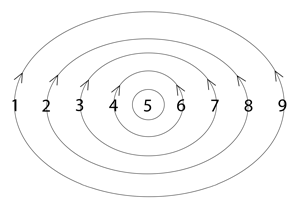within
9-2-2
Conventional Understanding
We’re constantly told to “go within” to find truth, peace, or our authentic self. Spiritual teachers, psychologists, and self-help books all point us inward as though wisdom waits inside us like treasure in a cave. This seemingly helpful guidance has become so common we rarely question it. By treating “within” as a direction toward which we should journey, we inadvertently create an artificial boundary between inner and outer experience. This subtly reinforces the very separation that spiritual practices claim to heal, positioning truth as something hidden “in here” that requires special techniques to access.
Resonant Understanding
Word Cosmology reveals “within” carrying a 9-2-2 resonance pattern, the same as “light” and “creative expression,” suggesting it’s not a direction at all but a quality of awareness itself. Like a stained glass window that doesn’t contain colors inside it but reveals them through its relationship with light, “within” doesn’t indicate a location where truth resides but shows how creative expression already manifests in awareness. Think of how a hologram doesn’t hide its image inside but reveals it through the interaction of light and pattern—similarly, what we seek by “going within” isn’t contained in an interior location but emerges through recognizing the creative expression already present in all experience.
Expressions Spectrum Analysis
In balanced expression, this resonance pattern appears as “creative expression,” “authentic,” and “heart coherence.” These qualities emerge when awareness flows without artificial boundaries, neither pushing “within” nor pulling from “without,” but simply present with creative expression as it naturally appears.
When over-modulated, expressions include “I am the creator of my life” and “ideological frameworks.” The directional quality of “within” becomes rigid—an interior territory to control or possess. The natural flow of creative expression gets channeled into a supposed “inner world” separate from outer experience.
Under-modulated expressions include “I cannot create,” “vague,” and “lonely.” The directional aspect of “within” becomes inaccessible—a supposed interior space that feels unreachable or overwhelming. There’s anxiety about not being able to properly access what’s supposedly “inside.”
Beyond modulation, terms like “light,” “still light,” and “creative expression” share this resonance pattern, suggesting that what directional language positions as “within” might actually be pointing toward the fundamental creative light that constitutes all experience—neither exclusively inside nor outside but present throughout all experience.
Russell’s Cosmogony Connection
Walter Russell described light not primarily as visible illumination but as “the zero fulcrum of the wave lever from which motion is projected. Its zero condition is eternal.” This explains why “within” shares resonance with “light”—what spiritual traditions direct us to find by “going within” isn’t located in an interior space but is the creative light that constitutes all experience.
Russell further explains: “In that Light there is no change, no variance of condition, no form and no motion. It is the zero universe of REALITY.” This illuminates why “going within” can create confusion: if light is the unified reality from which all experience extends, then treating “within” as a direction misunderstands light’s nature—which isn’t contained anywhere but constitutes the very substance of all experience.
Practical Implications
This understanding transforms spiritual practice in simple but profound ways. Rather than seeking truth by “going within”—as though wisdom were hidden in an interior location—we might recognize creative expression as already present in all experience, not requiring special journeys to access.
The directive to “go within” may actually reinforce the very separation it claims to heal by positioning truth as something “inside” that requires special techniques to reach. Instead, practices focused on “center” (1-1-2), which resonates with the generative beginning of the creative sequence, might offer a more accurate orientation than the reflective pattern of “within.”
Centering practices that simply align with the generative source from which both “inner” and “outer” experiences emerge often feel more immediately transformative than introspective practices that emphasize inward journeying. This isn’t about abandoning meditation or reflection but recognizing that what we’re seeking isn’t hidden away inside us—it’s the light of creative expression already illuminating all experience.
Walter Russell’s quotes are from his book, “A New Concept of the Universe.”


